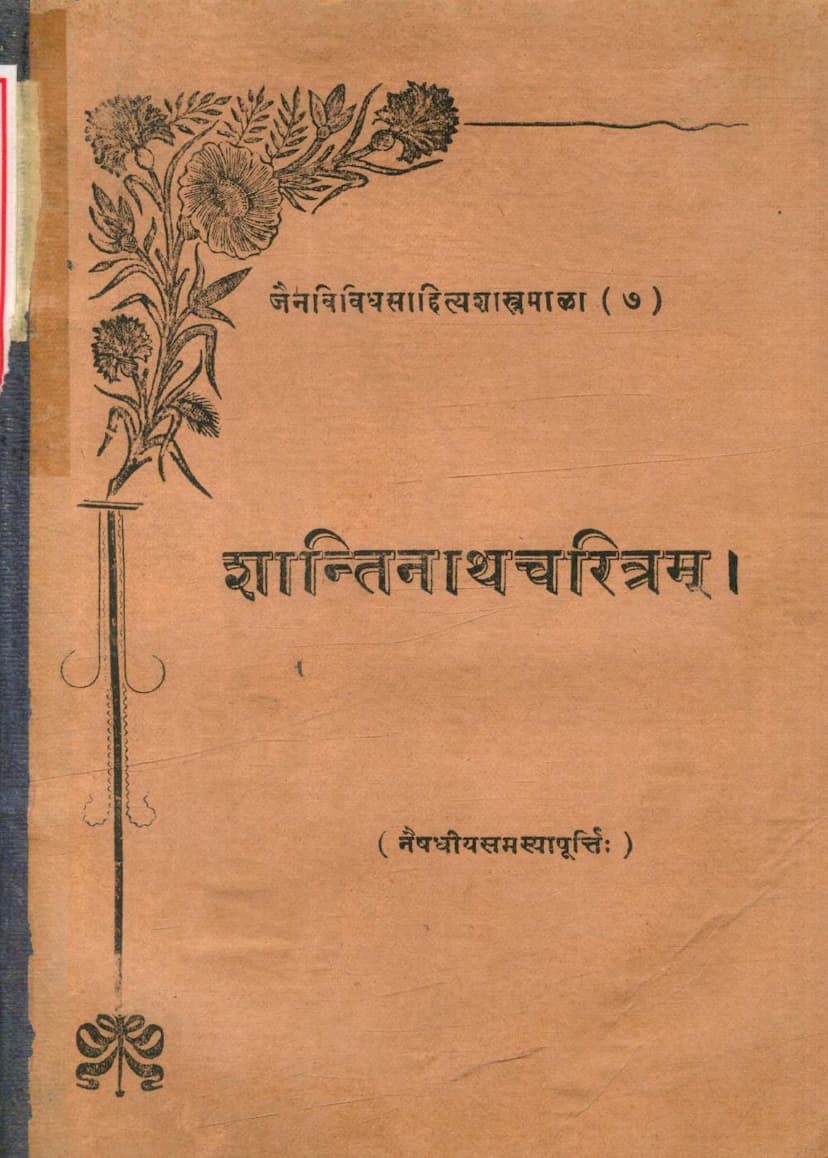Shantinath Charitram
Added to library: September 2, 2025

Summary
Here's a comprehensive summary of the Jain text "Shantinath Charitram" by Hargovinddas, based on the provided catalog link and scanned pages:
Book Title: Shantinath Charitram (शान्तिनाथ चरित्रम्) Author: Mahopádhyáya Shree Mecha Vijayji (महोपाध्याय श्री मेघविजयगणिविरचितं) Editor/Compiler: Pandit Hargovind Das T. Sheth (पण्डित हरगोविन्ददासेन परिष्कृत्य संशोधितम्) Publisher: Jain Vividh Sahitya Shastramala (जैनविविधसाहित्यशास्त्रमाला) Year of Publication: 1918 (Veer Samvat 2444) Catalog Link: https://jainqq.org/explore/023195/1
Core Concept:
The "Shantinath Charitram" is a significant Jain religious text that narrates the life story of the sixteenth Tirthankara, Lord Shantinath. What makes this particular work unique is its method of composition: it is a Samsya Purti (समस्यापूर्ति), meaning it fulfills a "problem" or challenge. Specifically, it uses verses from the renowned Sanskrit epic Naishadhiya Mahakavya (नैषधीय महाकाव्य) by Mahakavi Harsh (महाकवि श्रीहर्ष), adapting its verses to tell the story of Lord Shantinath from his birth to his liberation (Nirvana).
Key Features and Content:
- Authoritative Source: The work is authored by Mahopádhyáya Shree Mecha Vijayji, a respected Jain scholar. The text was then meticulously edited and revised by Pandit Hargovind Das T. Sheth, who was a lecturer in Sanskrit at Calcutta University and held the title Nyaya-Vyakarana-Tirth.
- Naishadhiya Samsya Purti: The primary characteristic is its fulfillment of the "Naishadhiya Samasya." This means that each verse of the Jain narrative is constructed by adapting or completing verses from the Naishadhiya Mahakavya. The editor notes that not just one line, but all four lines of each Naishadhiya verse are sequentially used or repeated in different contexts to form the Shantinatha narrative.
- Narrative Scope: The book covers the entire life of Lord Shantinath, from his conception and birth, through his princely life, his renunciation, his ascetic practices, the attainment of omniscience (Keval Gyan), his sermons, and finally, his liberation.
- Literary Style: The text is praised for its beautiful and flowing language, making the biography of Lord Shantinath accessible and engaging. The editor has organized the work into six sections (Sargas), following the structure of the original Naishadhiya.
- Adaptation Technique: The editor highlights that the adaptation involves placing the Naishadhiya verses in appropriate places within the narrative. Sometimes, a single line from the Naishadhiya might be repeated in different verses to convey varied meanings or nuances.
- Textual Variations: The preface acknowledges that there might be slight variations in the text of the Naishadhiya verses used compared to commonly available editions. However, it is noted that these variations are often found in commentaries or annotations of the Naishadhiya itself, suggesting the author might have used a specific or earlier recension. The editor also points out that minor differences like the addition or omission of an anusvara or visarga, or slight changes in letters (like 'l' for 'r'), are generally acceptable in such poetic compositions according to grammatical and literary principles.
- Editorial Process: Pandit Hargovind Das expresses his gratitude to Acharya Shree Vijaydharmasuriji for providing a nearly pure manuscript of the original work. He details his efforts in incorporating existing marginal notes (Tippanak) and adding his own where necessary, acknowledging the possibility of minor errors due to his own limitations.
- Lord Shantinath's Qualities: The text emphasizes Lord Shantinath's qualities such as his immense radiance, immense strength, just rule, compassion, and his ability to bring peace and tranquility, as reflected in his name "Shantinath" (Lord of Peace). The verses often draw parallels between his life and events or characters described in the Naishadhiya, particularly related to King Nala.
- Historical Context: The publication date of 1918 places it within a period of significant activity in the revival and dissemination of Jain literature. The publisher, Jain Vividh Sahitya Shastramala, was dedicated to publishing and preserving Jain scriptures.
In essence, "Shantinath Charitram" is a masterful blend of devotional biography and sophisticated Sanskrit literary artistry. It demonstrates how classical poetic frameworks can be creatively employed to recount the profound lives of Jain Tirthankaras, offering a unique and engaging reading experience for Jain devotees and scholars of Indian literature.